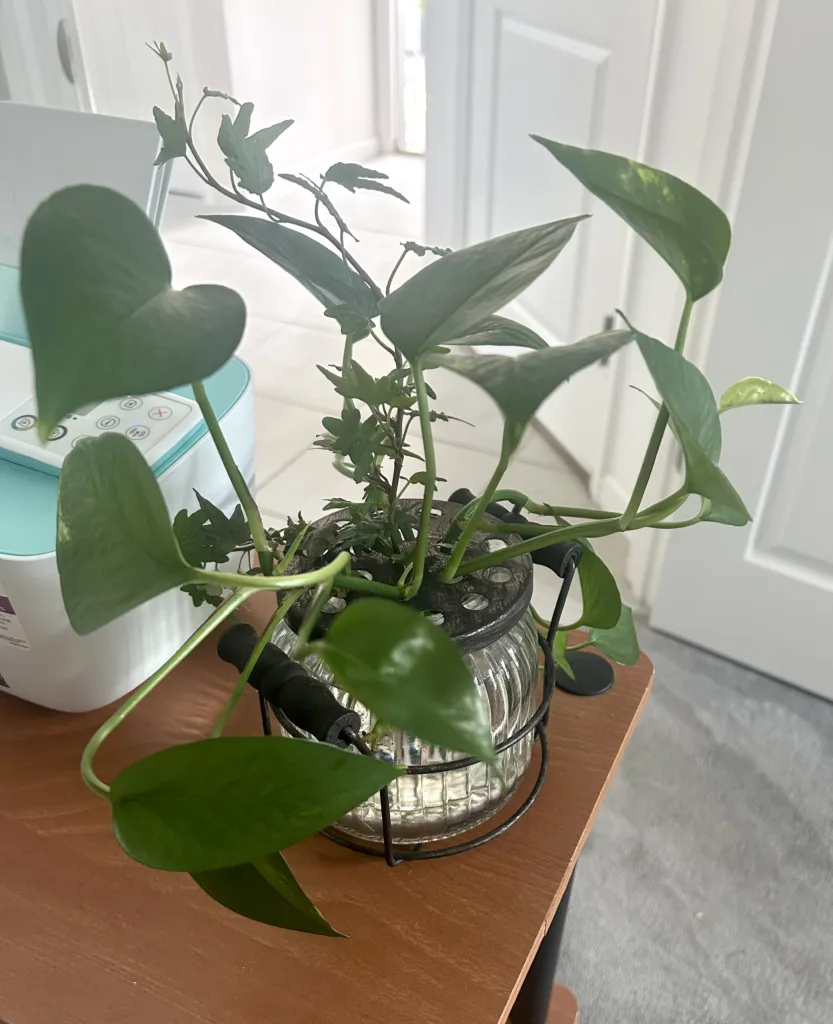Are you looking for an indoor plant that can liven up your home decor without requiring too much attention? The Jade Pothos, a trailing vine is a low-maintenance houseplant that can grow up to 6 feet long, making it a great addition to your living room, kitchen, or workspace. But how do you take care of a Jade Pothos properly? In this blog post, we’ll share all the tips and tricks on how to grow and care for this beautiful plant, including pot type, soil type, water and light requirements, fertilizer, and propagation.
Pot Type for Jade Pothos
Let’s start with the pot type. Jade Pothos is a versatile plant that can grow in a wide range of containers, from classic terracotta pots to modern ceramic planters, as long as they have proper drainage holes. When choosing a pot, make sure it is large enough to accommodate the plant’s root system, but not too big, as excess soil can hold too much moisture and lead to root rot. If you prefer a minimalist look, you can even hang the Jade Pothos in a macrame planter or a wall-mounted pot holder.
Best Soil Type for Jade Pothos
Like most houseplants, Jade Pothos prefers well-draining soil that is rich in organic matter. You can use a potting mix specifically designed for indoor plants, or make your own by combining equal parts of peat moss, perlite, and vermiculite. Avoid using heavy garden soil or sand, as they don’t allow for proper water and air circulation. If you want to enhance the soil’s fertility, you can add some slow-release fertilizer or compost.
Water and Light Requirements
Jade Pothos likes to be watered regularly, but not too frequently. Ideally, you should water the plant when the top inch of soil feels dry to the touch. Overwatering can lead to root rot and yellowing leaves, while underwatering can make the plant wilt and turn brown. It’s also essential to avoid getting water on the leaves, as they are prone to fungal diseases.
When it comes to light, Jade Pothos is a shade-loving plant that can tolerate low to medium light levels. Direct sunlight can scorch the leaves and cause them to drop off. However, if you notice that your Jade Pothos is growing slowly or leggy, you may need to move it to a brighter spot. If you don’t have the perfect window you can always use a grow light.
Fertilizer Needs
To keep your Jade Pothos healthy and thriving, you should fertilize it once a month during the growing season (spring and summer) with a balanced liquid fertilizer. This will provide the plant with the essential nutrients it needs, such as nitrogen, phosphorus, and potassium. Be careful not to over-fertilize, as this can burn the roots and cause leaf tip burn. You can also use organic fertilizers, such as fish emulsion or compost tea, for a more natural approach.
Propagating Jade Pothos
Last but not least, let’s talk about propagation. Jade Pothos is a super easy plant to propagate, and you can do it in several ways. One method is to take stem cuttings of about 4-6 inches long, remove the bottom leaves, and place them in water in a propagation station until roots form. Or you can plant cutting directly in pot filled with moist soil. Within a few weeks, the cuttings will develop roots and start to grow. Another method is to divide the plant at the root ball, which is a good option if your Jade Pothos has become too large for its pot. Simply gently remove the plant from the pot, separate the roots, and replant them in fresh soil.
Growing Pothos in Water Alone
Pothos can be grown in water as well. To do this, you’ll need a glass jar or other unique container filled with filtered tap water. Place your pothos plant in the jar and ensure that all the roots are submerged in the water. Change out the water every 2-3 weeks and fertilize it with liquid fertilizer every month to keep it healthy and growing. I have a variety of pothos in a beautiful vase in my office and love having a plant on my desk.

Happy Gardening!
Now that you know all about Jade Pothos, you can confidently take care of this gorgeous plant and enjoy its lush foliage year-round. Remember to choose a suitable pot with drainage holes, use well-draining soil, water and fertilize regularly but moderately, provide low to medium light, and propagate whenever you want to expand your collection.
Please be sure to check out my Gardening Blog Post Page for more tips on all types of gardening. Including Seed Saving, Seed Starting, Orchids, Water Gardening, Coldframe Gardening, Indoor Bulb Gardening, Hydroponics, Container Gardening, Mums, Herbs, African Violets, planting Bulbs, Flower Gardening, Vegetable and Fruit Gardening, Indoor Houseplants of all kinds, Cactus, Succulents, Hanging plants, Deer resistant plants and even Bird, Bee, Butterfly and Hummingbird Gardens!
